Evaluation of Shale Oil Mobility for the Eocene Shahejie Formation in Liutun Sag, Dongpu Depression, Bohai Bay Basin
Abstract
1. Introduction
2. Geological Background
3. Samples and Methods
4. Results
4.1. Pyrolysis and Extraction
4.2. Mineral Analysis
4.3. Organic Matter Type and Maturity
4.4. Shale Oil Occurrence State
5. Discussion
5.1. Factors Affecting the Shale Oil Occurrence State
5.1.1. Mineral Composition
5.1.2. Organic Matter Type, Abundance, and Maturity
5.1.3. Shale Oil Composition
5.2. Shale Oil Intrasource Migration
5.2.1. The Threshold of Hydrocarbon Expulsion
5.2.2. The Process of Hydrocarbon Expulsion
5.2.3. The Evaluation of Shale Oil Mobility
6. Conclusions
Author Contributions
Funding
Data Availability Statement
Acknowledgments
Conflicts of Interest
References
- Zhou, Q.F.; Yang, G.F. Definition and application of tight oil and shale terms. Oil Gas Geol. 2012, 4, 541–544, (In Chinese with English abstract). [Google Scholar]
- Zhi, D.M.; Tang, Y.; Yang, Z.F.; Guo, X.G.; Zheng, M.G.; Wan, M.; Huang, L.L. Geological characteristics and accumulation mechanism of continental shale oil in Jimusaer sag, Junggar Basin. Oil Gas Geol. 2019, 40, 524–534, (In Chinese with English abstract). [Google Scholar]
- Jarvie, D.M. Components and processes affecting producibility and commerciality of shale resource systems. Geol. Acta 2014, 12, 307–325. [Google Scholar]
- Chen, J.P.; Sun, Y.G.; Zhong, N.N. The efficiency and model of petroleum expulsion from the lacustrine source rocks within geological frame. Acta Geol. Sin. 2014, 88, 2005–2032. [Google Scholar]
- Radwan, A.E.; Husinec, A.; Benjumea, B.; Kassem, A.A.; Abd El Aal, A.K.; Hakimi, M.H.; Thanh, H.V.; Abdel-Fattah, M.I.; Shehata, A.A. Diagenetic overprint on porosity and permeability of a combined conventional-unconventional reservoir: Insights from the Eocene pelagic limestones, Gulf of Suez, Egypt. Mar. Pet. Geol. 2022, 146, 105967. [Google Scholar] [CrossRef]
- Jiang, Q.G.; Li, M.W.; Ma, Y.Y. Molecular geochemical evaluation of shale oil mobility: A case study of shale oil in Jiyang Depression. Pet. Geol. Exp. 2018, 40, 849–854. [Google Scholar]
- Li, J.J.; Liu, Z.; Li, J.Q.; Lu, S.F.; Zhang, T.Q.; Zhang, X.W.; Yu, Z.Y. Fractal characteristics of continental shale pores and its significance to the occurrence of shale oil in China: A case study of Biyang Depression. Fractals 2018, 26, 1840008. [Google Scholar] [CrossRef]
- Niu, D.M.; Li, Y.L.; Zhang, Y.F.; Sun, P.C.; Wu, H.G.; Fu, H.; Wang, Z.Q. Multi-scale classification and evaluation of shale reservoirs and ‘sweet spot’ prediction of the second and third members of the Qingshankou Formation in the Songliao Basin based on machine learning. J. Pet. Sci. Eng. 2022, 216, 110678. [Google Scholar] [CrossRef]
- Li, H.; Lu, J.L.; Wang, B.H.; Lu, K.; Zhou, Y.; Wang, M.; Zhao, L.J.; Song, Z.C. Controlling factors of continental shale oil mobility and resource potential in Dongpu Sag, Bohai Bay Basin. Pet. Geol. Exp. 2020, 4, 632–638. [Google Scholar]
- Evenick, J.C.; McClain, T. Method for characterizing source rock organofacies using bulk rock composition. AAPG Mem. 2013, 103, 71–80. [Google Scholar]
- Peng, J.W.; Pang, X.Q.; Shi, H.S. Hydrocarbon generation and expulsion characteristics of Eocene source rocks in the Huilu area, northern Pearl River Mouthbasin, South China Sea: Implications for tight oil potential. Mar. Pet. Geol. 2016, 72, 463–487. [Google Scholar] [CrossRef]
- Li, Y.; Wu, H.; Zhang, Y.; Liao, Z.; Hu, W.; Fu, H.; Li, Z. Reservoir diversity and its genetic mechanism in the Es4 abnormally high-porosity zone of deep sandstone in the Bonan step-fault zone, Bonan Sag, Bohai Bay Basin, China. J. Pet. Sci. Eng. 2020, 191, 107216. [Google Scholar] [CrossRef]
- Demaison, G.J.; Moore, G.T. Anoxic environments and oil source bed genesis. AAPG Bull 1980, 64, 1179–1209. [Google Scholar] [CrossRef]
- Hu, T.; Pang, X.Q.; Wang, Q.F. Geochemical and geological characteristics of Permian Lucaogou Formation shale of the well Ji174, Jimusar Sag, Junggar Basin, China: Implications for shale oil exploration. Geol. J. 2017, 4, 1–15. [Google Scholar] [CrossRef]
- Zhang, J.C.; Lin, L.M.; Li, Y.X. Classification and evaluation of shale oil. Earth Sci. Front. 2012, 19, 322–331. [Google Scholar]
- Zou, C.N.; Yang, Z.; Cui, J.M.; Zhu, R.K.; Hou, L.H. Formation mechanism, geological characteristics and development strategy of nonmarine shale oil in China. Pet. Explor. Dev. 2013, 40, 14–26, (In Chinese with English abstract). [Google Scholar] [CrossRef]
- Jiang, Q.G.; Li, M.W.; Qian, M.H.; Li, Z.M.; Li, Z.; Huang, Z.K. Quantitative characterization of shale oil in different occurrence states and its application. Pet. Geol. Exp. 2016, 38, 842–849. [Google Scholar]
- Espitalié, J.; Madec, M.; Tissot, B. Role of mineral matrix in kerogen pyrolysis: Influence on petroleum generation and migration. AAPG Bull. 1980, 64, 59–66. [Google Scholar]
- Han, Y.; Mahlstedt, N.; Horsfield, B. The Barnett Shale: Compositional fractionation associated with intraformational petroleum migration, retention, and expulsion. AAPG Bull. 2015, 99, 2173–2202. [Google Scholar] [CrossRef]
- Pepper, A.S.; Corvi, P.J. Simple kinetic models of petroleum formation. Part III modeling an open system. Marine and Petroleum Geology 1995, 12, 417–452. [Google Scholar] [CrossRef]
- Sandvik, E.I.; Young, W.A.; Curry, D.J. Expulsion from hydrocarbon sources; the role of organic absorption. Org. Geochem. 1992, 19, 77–87. [Google Scholar] [CrossRef]
- Sarmiento, M.F.; Ducros, M.; Carpentier, B.; Lorant, F.; Cacas, M.-C.; Pegaz-Fiornet, S.; Wolf, S.; Rohais, S.; Moretti, I. Quantitative evaluation of TOC, organic porosity and gas retention distribution in a gas shale play using petroleum system modeling: Application to the Mississippian Barnett Shale. Mar. Pet. Geol. 2013, 45, 315–330. [Google Scholar] [CrossRef]
- Tissot, B.P.; Welte, D.H. Petroleum Formation and Occurrence, 2nd ed.; Springer: Berlin/Heidelberg, Germany, 1984; Volume 2, pp. 699–702. [Google Scholar]
- Behar, F.; Beaumont, V.; Penteado, H.L.D. Rock-Eval 6 technology: Performances and developments. Oil Gas Sci. Technol.-Rev. IFP 2001, 56, 111–134. [Google Scholar] [CrossRef]
- Chen, Z.H.; Li, M.W.; Jiang, C.Q.; Qian, M. H Shale oil resource potential and its mobility assessment: A case study of Upper Devonian Duvernay shale in Western Canada Sedimentary Basin. Oil Gas Geol. 2019, 40, 459–468, (In Chinese with English abstract). [Google Scholar]
- Espitalié, J.; Laporte, J.L.; Madec, M.; Marquis, F.; Leplat, P.; Paulet, J.; Boutefeu, A. Méthode rapide de caractérisation des roches mères, de leur potentiel pétrolier et de leur degré d’évolution. Rev. L institut Français Pet. Ann. Combust. Liq. (Rev. Inst. Fr. Pét.) 1977, 32, 23–43. [Google Scholar] [CrossRef]
- Espitalié, J. Use of Tmax as a maturation index for different types of organic matter. Comparison with vitrinte reflectance. In Thermal Modeling in Sedimentary Basins; Burrus, J., Ed.; Editions Technip: Paris, France, 1986; pp. 475–496. [Google Scholar]
- Claypool, G.E.; Reed, P.R. Thermal-analysis technique for source-rock evaluation: Quantitative estimate of organic richness and effects of lithologic variation. AAPG Bull. 1976, 60, 608–626. [Google Scholar]
- Clementz, D.M. Effect of oil and bitumen saturation on source-rock pyrolysis. AAPG Bull. 1979, 63, 2227–2232. [Google Scholar]
- Delvaux, D.; Martin, H.; Leplat, P.; Paulet, J. Geochemical characterization of sedimentary organic matter by means of pyrolysis kinetic parameters. Org. Geochem. 1990, 16, 175–187. [Google Scholar] [CrossRef]
- Jarvie, D.M. Shale resource systems for oil and gas: Part 2—Shale-oil resource systems. In Shale Reservoirs—Giant Resources for 21st Century; Beyer, J.A., Ed.; AAPG Memoir; American Association of Petroleum Geologists: Mattulsa, OK, USA, 2012; Volume 97, pp. 89–119. [Google Scholar]
- Zink, K.G.; Scheeder, G.; Stueck, H.L.; Biermann, S.; Blumenberg, M. Total shale oil inventory from an extended Rock-Eval approach on non-extracted and extracted source rocks from Germany. Int. J. Coal Geol. 2016, 163, 186–194. [Google Scholar] [CrossRef]
- Zhang, W.C.; Yang, D.X.; Chen, Y.J. Sedimentary Structural Characteristics and Hydrocarbon Distributed Rules of Jizhong Depression. Acta Geol. Sin. 2008, 8, 1103–1112. [Google Scholar]
- Zhang, H.; Li, S.; Xu, T. Characteristics and formation mechanism for the saline lacustrine oil from the north Dongpu sag. Geoscience 2017, 31, 768–778, (In Chinese with English abstract). [Google Scholar]
- Zhang, H.; Xu, T.; Zhang, Y. Development characteristics and significance of high quality source rocks of salty lake in Dongpu Depression. Fault-Block Oil Field 2017, 24, 437–441, (In Chinese with English abstract). [Google Scholar]
- Zhang, K.X.; Qi, J.F.; Zhao, Y.B. Structure and Evolution of Cenozoic in Dongpu Sag. Xinjiang Pet. Geol. 2007, 6, 714–717, (In Chinese with English abstract). [Google Scholar]
- Li, Z.M.; Liu, P.; Qian, M.H.; Li, M.W. Quantitative comparison of different occurrence oil for lacustrine shale: A case from cored interval of shale oil special drilling wells in Dongying depression, Bahai Bay basin. J. China Univ. Min. Technol. 2018, 43, 566–576, (In Chinese with English abstract). [Google Scholar]
- Penteado, H.L.B.; Behar, F. Geochemical characterization and compositional evolution of the Gomo Member source rocks in the Reconcavo Basin. AAPG Mem. 2000, 73, 179–194. [Google Scholar]
- Vandenbroucke, M.; Largeau, C. Kerogen origin, evolution and structure. Org. Geochem. 2007, 38, 719–833. [Google Scholar] [CrossRef]
- Rudkiewicz, J.L.; Behar, F. Influence of kerogen type and TOC content on multiphase primary migration. Org. Geochem. 1994, 21, 121–133. [Google Scholar] [CrossRef]
- Young, A.; McIver, R.D. Distribution of hydrocarbons between oils and associated fine-grained sedimentary rocks—Physical chemistry applied to petroleum geochemistry. AAPG Bull. 1977, 61, 1407–1436. [Google Scholar]
- Leythaeuser, D.; Schaefer, R.G.; Radke, M. Geochemical effects of primary migration of petroleum in Kimmeridge source rocks from Brae field area, North Sea. I: Gross composition of C15þ-soluble organic matter and molecular composition of C15þ-saturated hydrocarbons. Geochim. Cosmochim. Acta 1988, 52, 701–713. [Google Scholar] [CrossRef]
- Lewan, M.D. Laboratory simulation of petroleum formation, hydrous pyrolysis. In Organic Geochemistry; MEngel, H., Macko, S.A., Eds.; Plenum Press: New York, NY, USA, 1993; pp. 419–442. [Google Scholar]
- Hunt, J.M. Petroleum Geochemistry and Geology; W.H. Freeman and Company: New York, NY, USA, 1996; p. 746. [Google Scholar]
- Bohacs, K.M.; Passey, Q.M.; Rudnicki, W.L.; Lazar, O.R. The spectrum of fine-grained reservoirs from “shale-gas” to “shale oil”/tight liquids: Essential attributes, key controls, practical characterization. In Proceedings of the International Petroleum Technology Conference, Beijing, China, 26–28 March 2013. [Google Scholar]
- Cook, A.C.; Sherwood, N.R. Classification of oil shales, coals, and other organic-rich rocks. Org. Geochem. 1991, 17, 211–222. [Google Scholar] [CrossRef]
- Loucks, R.G.; Reed, R.M.; Ruppel, S.C.; Jarvie, D.M. Morphology, genesis, and distribution of nanometer-scale pores in siliceous mudstones of the Mississippian Barnett Shale. J. Sediment. Res. 2009, 79, 848–861. [Google Scholar] [CrossRef]
- Dahl, J.; Chen, R.T.; Kaplan, I.R. Alum Shale bitumen maturation and migration: Implications for Gotland’s oil. J. Pet. Geol. 1989, 12, 465–476. [Google Scholar] [CrossRef]
- Selby, D.; Creaser, R.A.; Dewing, K.; Fowler, M. Evaluation of bitumen as 187Re-187Os geochronometer for hydrocarbon maturation and migration: A test case from Polaris MVT deposit, Canada. Earth Planet. Sci. Lett. 2005, 235, 1–15. [Google Scholar] [CrossRef]
- Thomas, M.M.; Clouse, J.A. Primary migration by diffusion through kerogen: I. Model experiments with organic-coated rocks. Geochim. Cosmochim. Acta 1990, 54, 2775–2779. [Google Scholar] [CrossRef]
- Okui, A.; Waples, D.W. Relative Permeabilities and Hydrocarbon Expulsion from Source Rocks, Basin Modelling: Advances and Applications; Elsevier: Amsterdam, The Netherlands, 1993; pp. 293–301. [Google Scholar]
- Mann, U. An Integrated Approach to the Study of Primary Petroleum Migration. In Geological Society; Special Publications: London, UK, 1994; Volume 78, pp. 233–260. [Google Scholar]
- Modica, C.J.; Lapierre, S.G. Estimation of kerogen porosity in source rocks as a function of thermal transformation: Example from the Mowry Shale in the Powder River Basin of Wyoming. AAPG Bull. 2012, 96, 87–108. [Google Scholar] [CrossRef]
- Hunt, J.M.; Whelan, J.K.; Eglinton, L.B.; Cathles, L.M. Relation of shale porosities, gas generation, and compaction to deep overpressures in the U.S. Gulf Coast. In Abnormal Pressures in Hydrocarbon Environments; Law, B.E., Ulmishek, G.F., Slavin, V.I., Eds.; USGS Publications Warehouse: Virgina, VA, USA, 1998; pp. 87–104. [Google Scholar]
- Huang, Z.K.; Hao, Y.Q.; Li, S.J.; Wo, Y.J.; Sun, D.S.; Li, M.W.; Chen, J.P. Oil−bearing potential, mobility evaluation and significance of shale oil in Chang7 shale system in the Ordos Basin: A case study of well H317. Geol. China 2020, 47, 210–219, (In Chinese with English abstract). [Google Scholar]
- Li, J.J.; Wang, W.M.; Cao, Q.; Shi, Y.G.; Yan, X.T. Impact of hydrocarbon expulsion efficiency of continental shale upon shale oil accumulations in eastern China. Mar. Pet. Geol. 2015, 59, 467–479, (In Chinese with English abstract). [Google Scholar]
- Welte, D. Migration of hydrocarbons. Facts and theory. In Migration of Hydrocarbons in Sedimentary Basins; Doligez, B., Ed.; Technip: Paris, France, 1987; pp. 393–413. [Google Scholar]
- Wang, Y.S.; Li, Z.; Gong, Z.; Hao, Y.Q.; Hao, X.F.; Wang, Y. Discussion on evaluation method of shale oil and gas in Jiyang depression: A case study on Luo jia area in Zhanhua sag. Acta Pet. Sin. 2013, 34, 83–91. [Google Scholar]
- Li, J.B. Study on Occurrence Mechanism and Mobility of Shale Oil: A Case Study of Shahejie Formation in Jiyang Depression. Ph.D. Thesis, China University of Petroleum (Huadong), Qingdao, China, 2020. (In Chinese with English abstract). [Google Scholar]

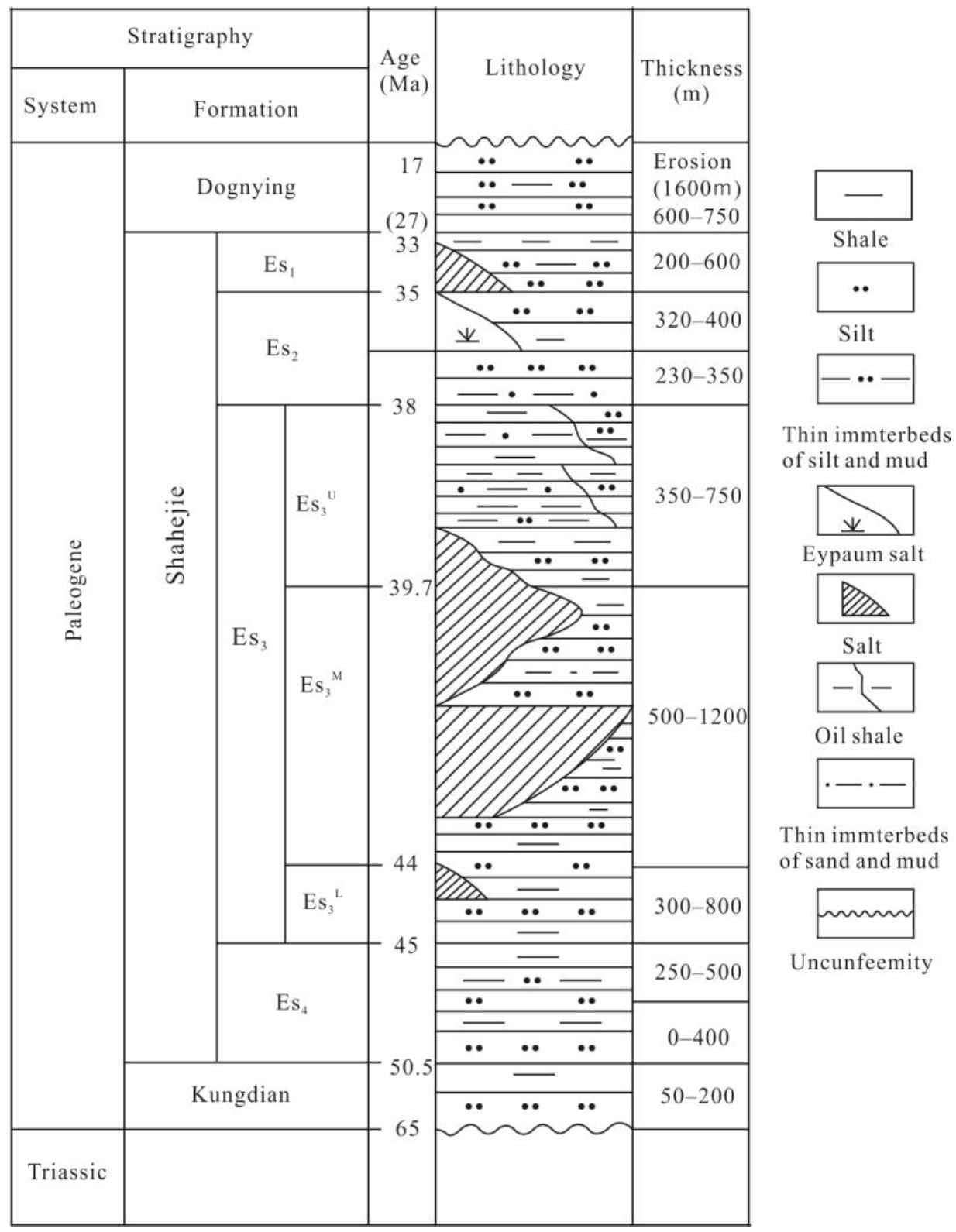
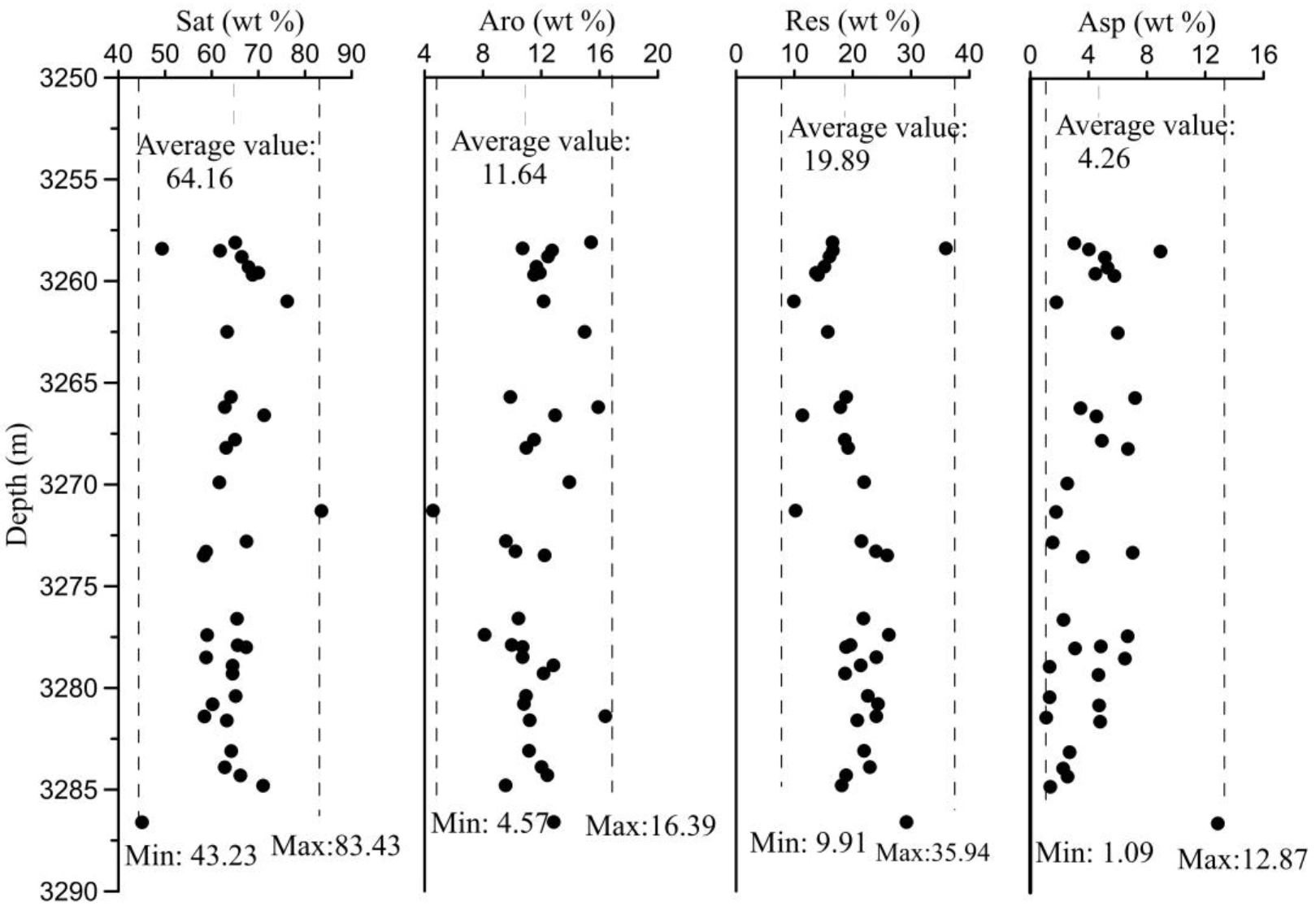
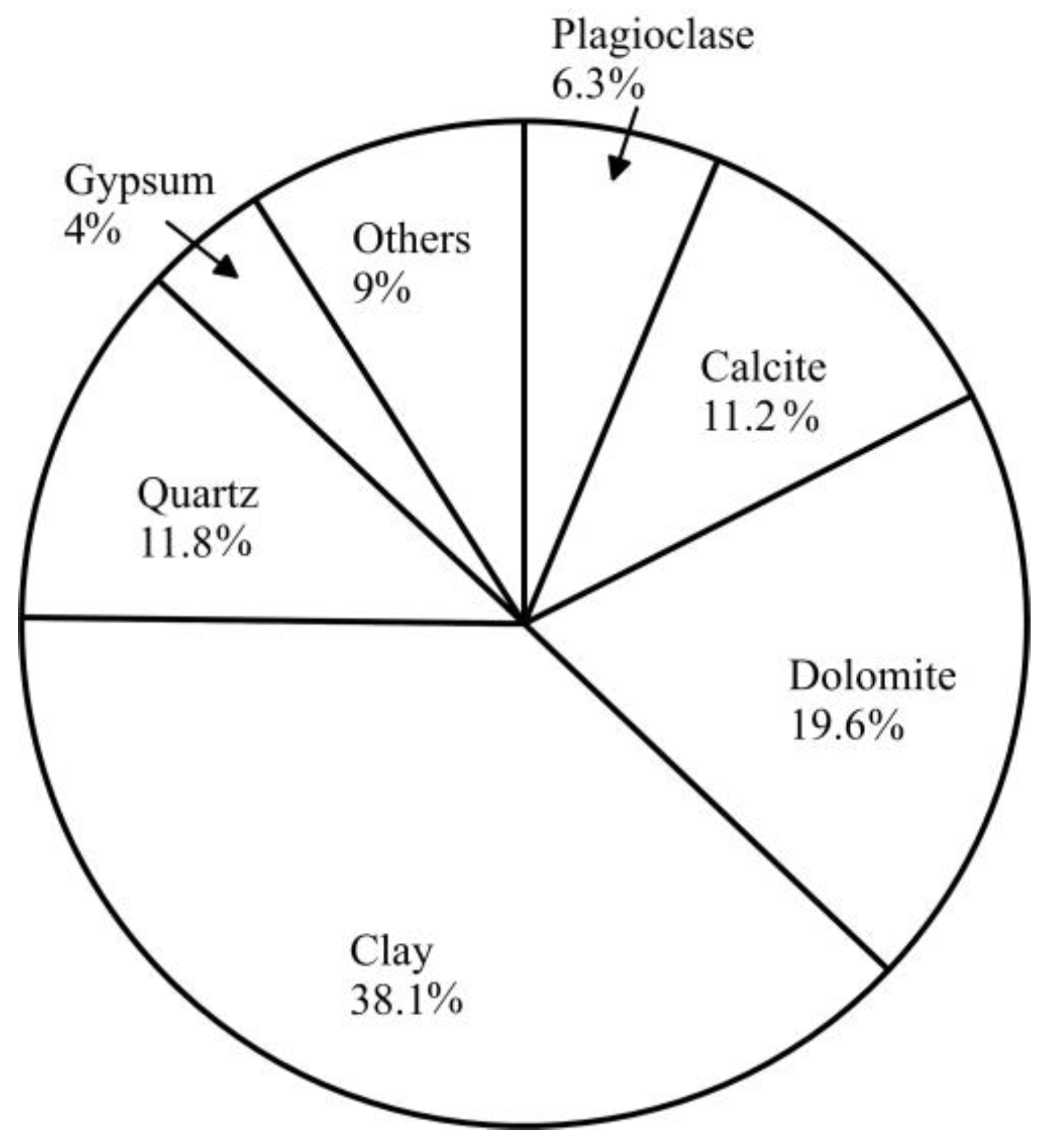
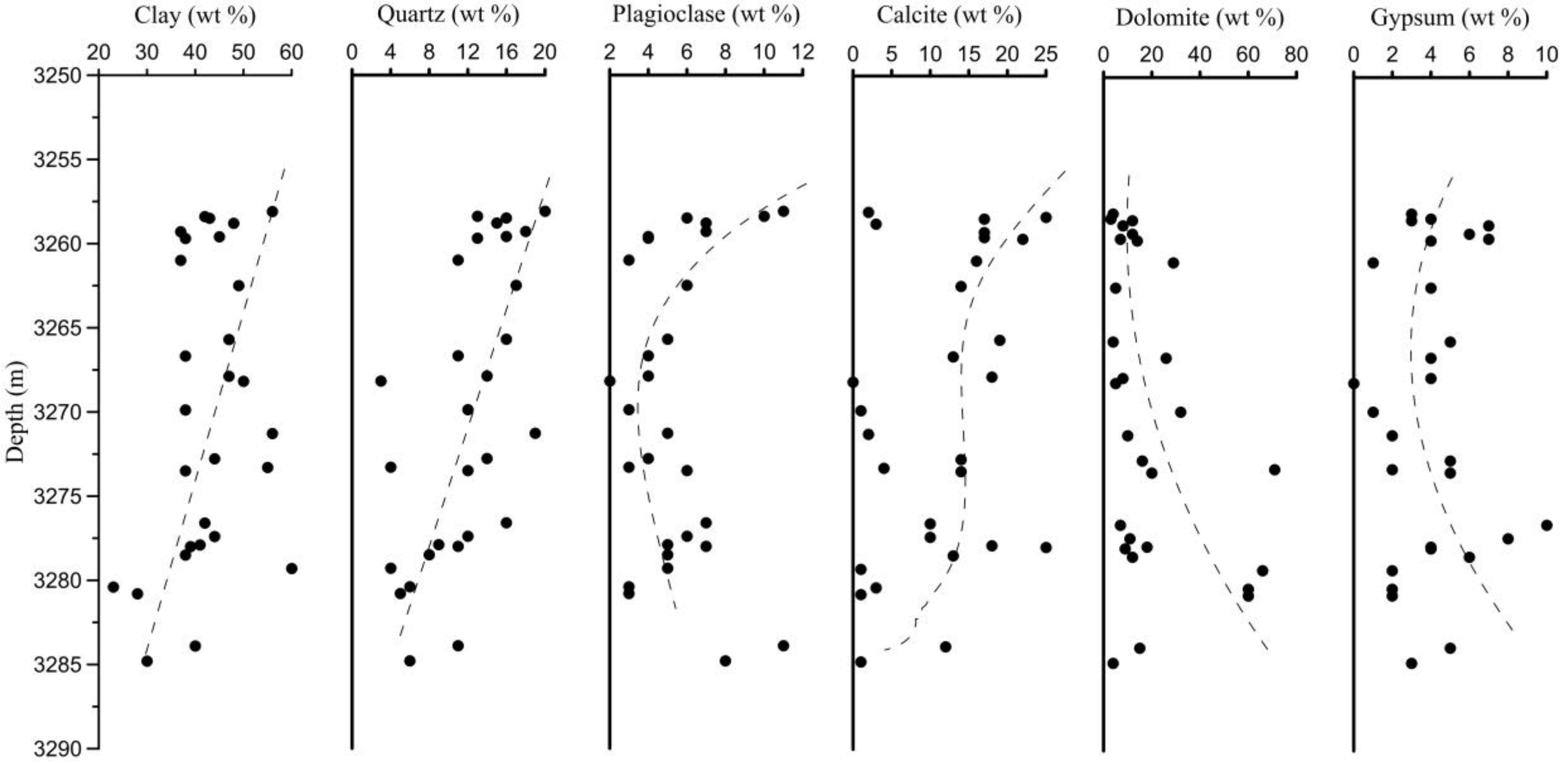
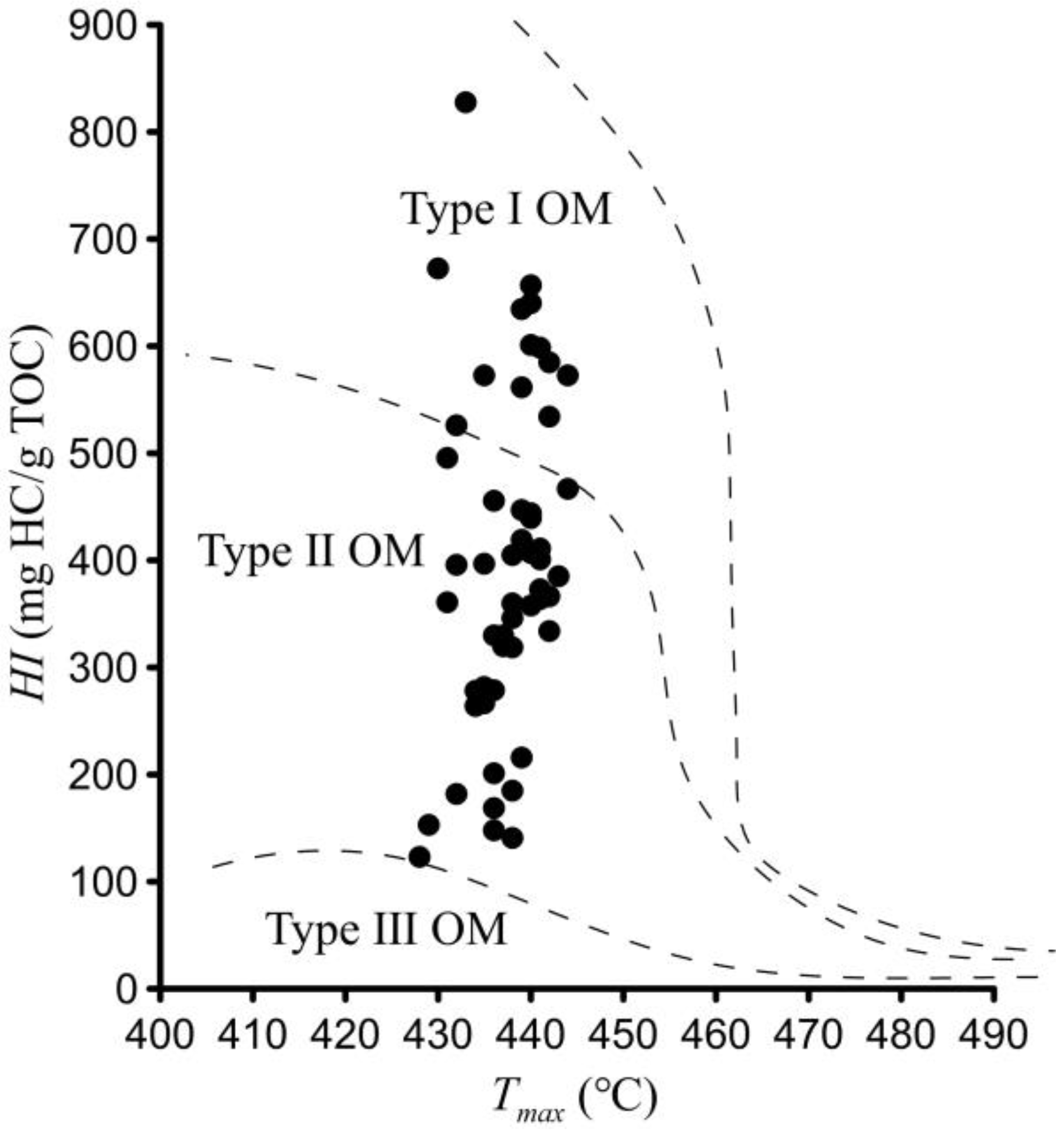

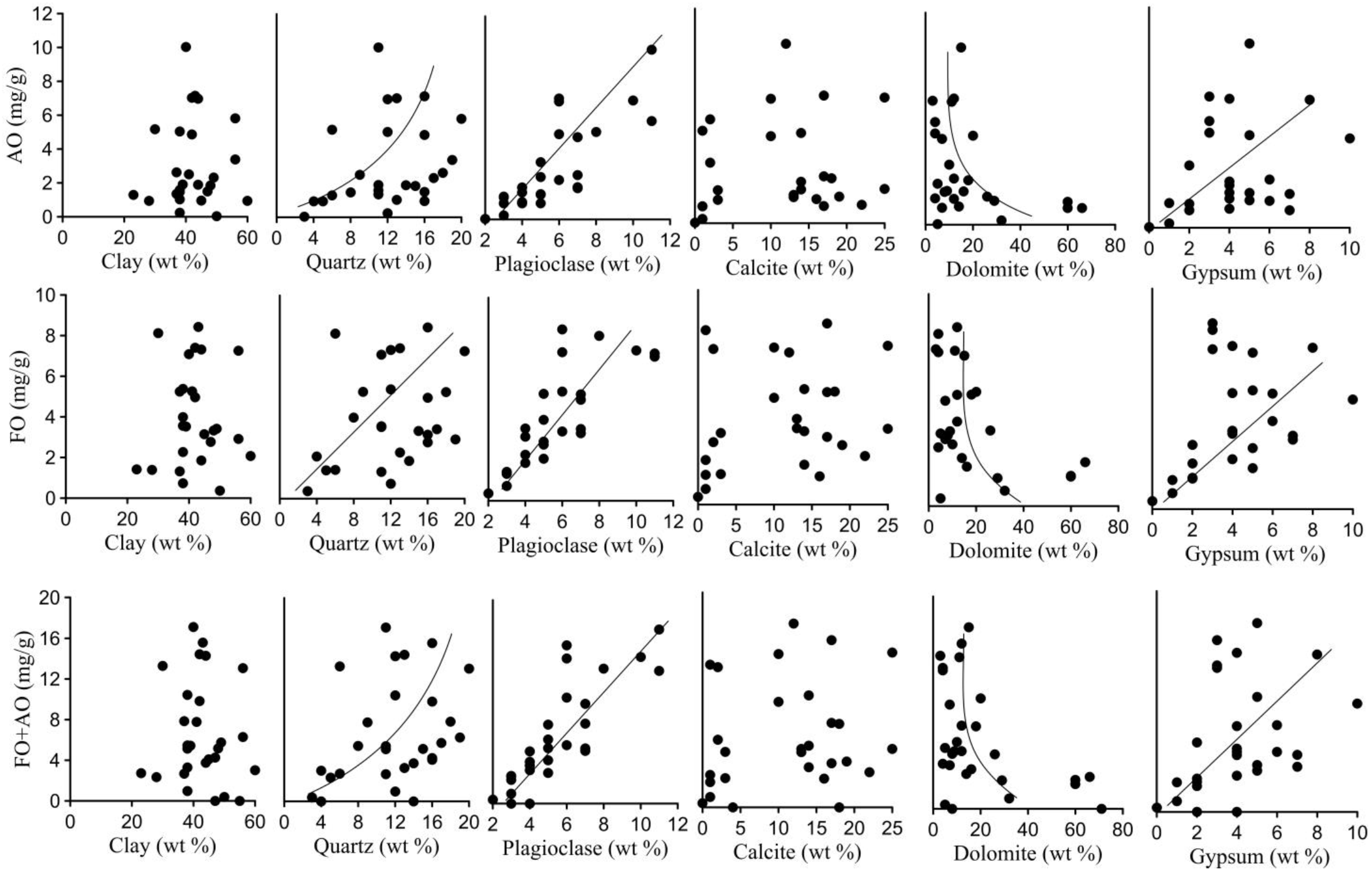
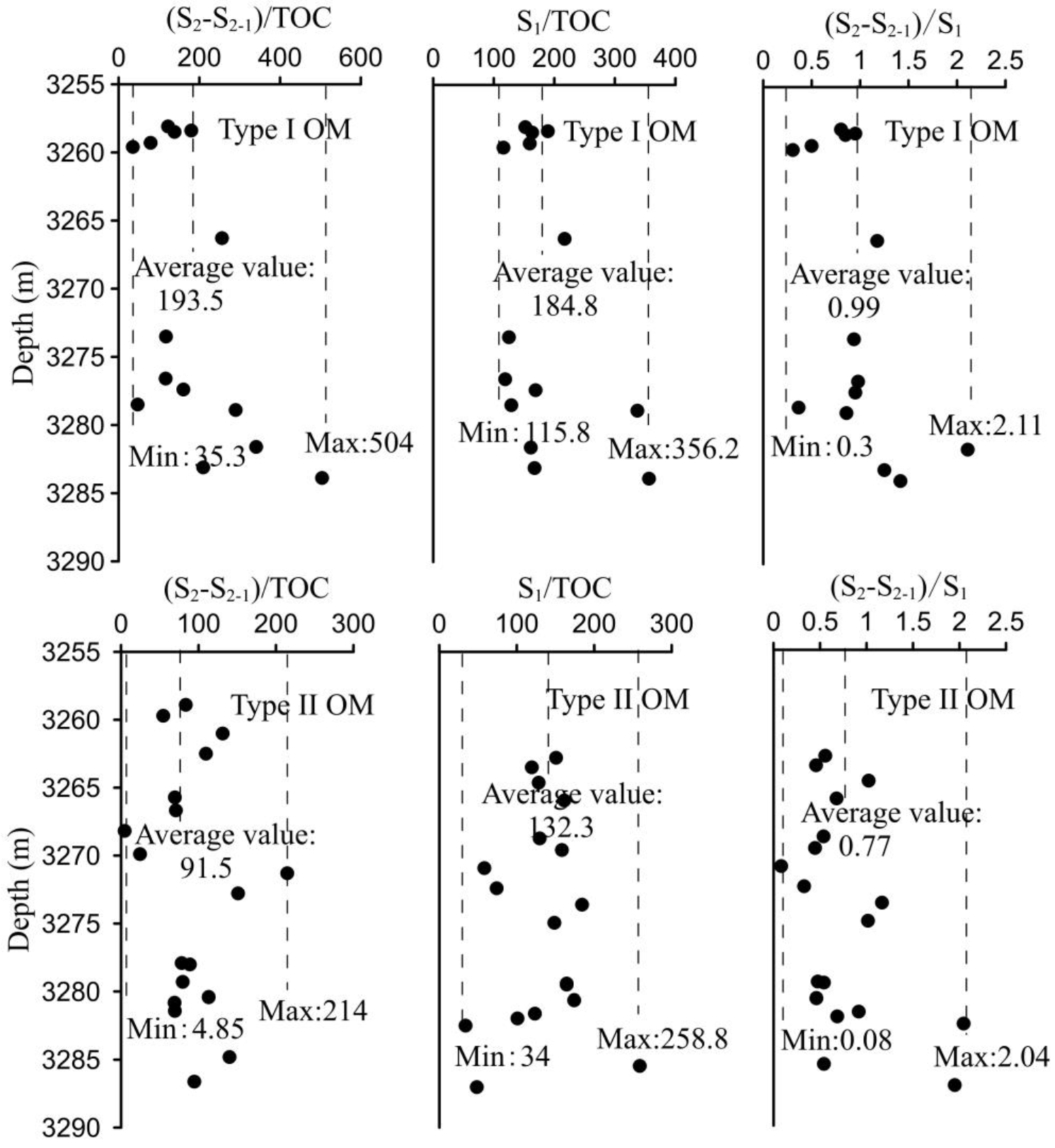
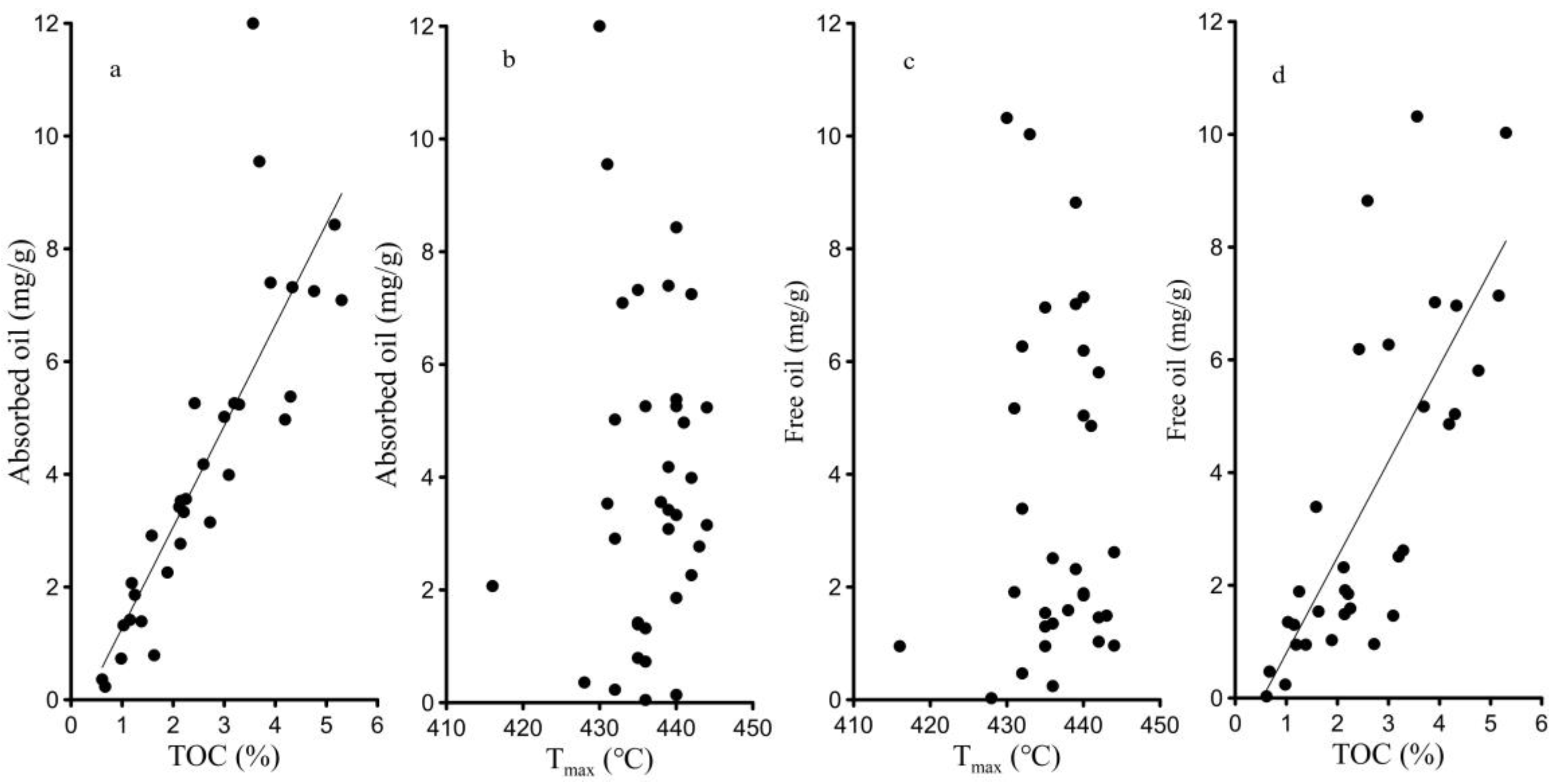


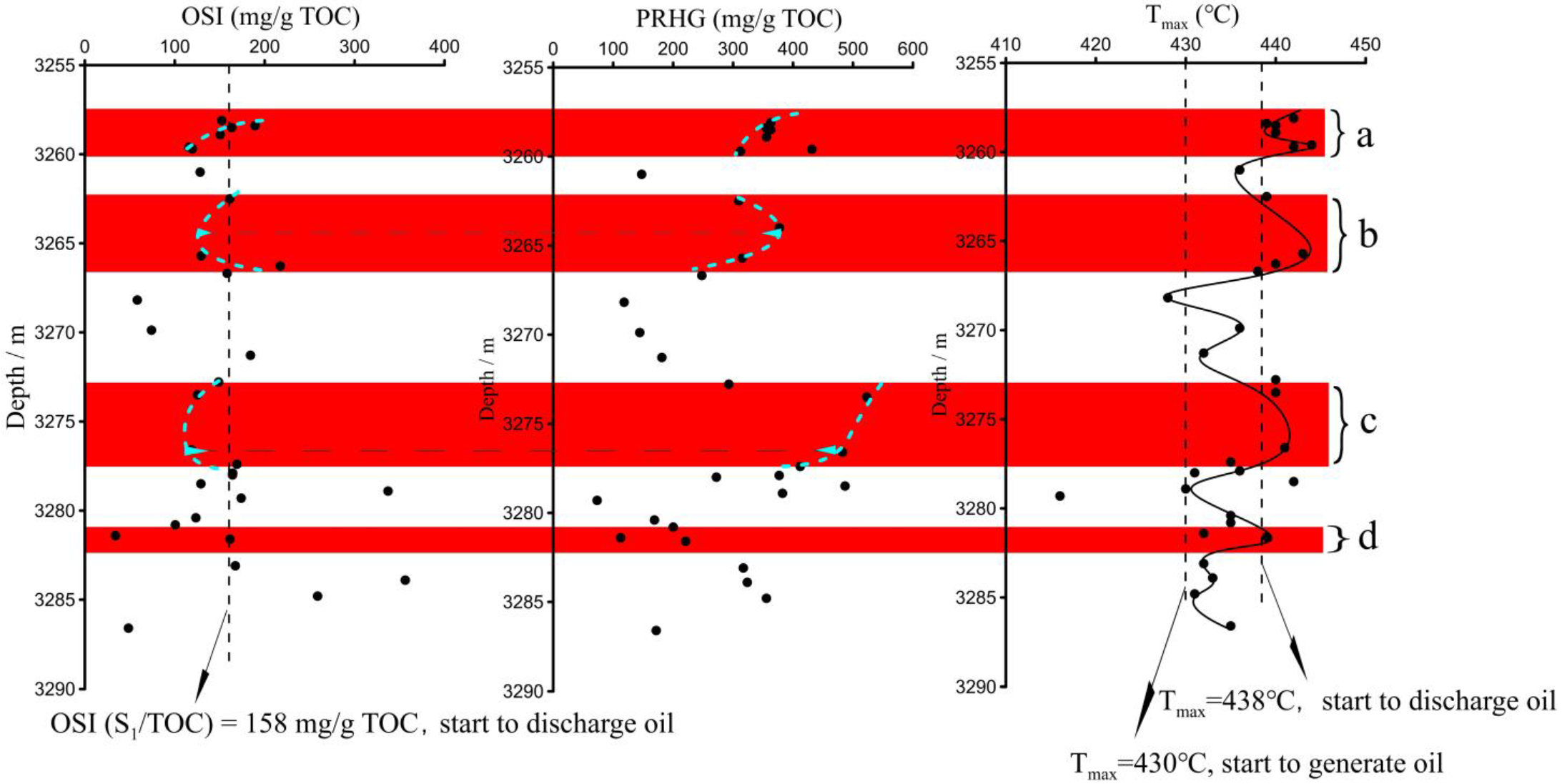
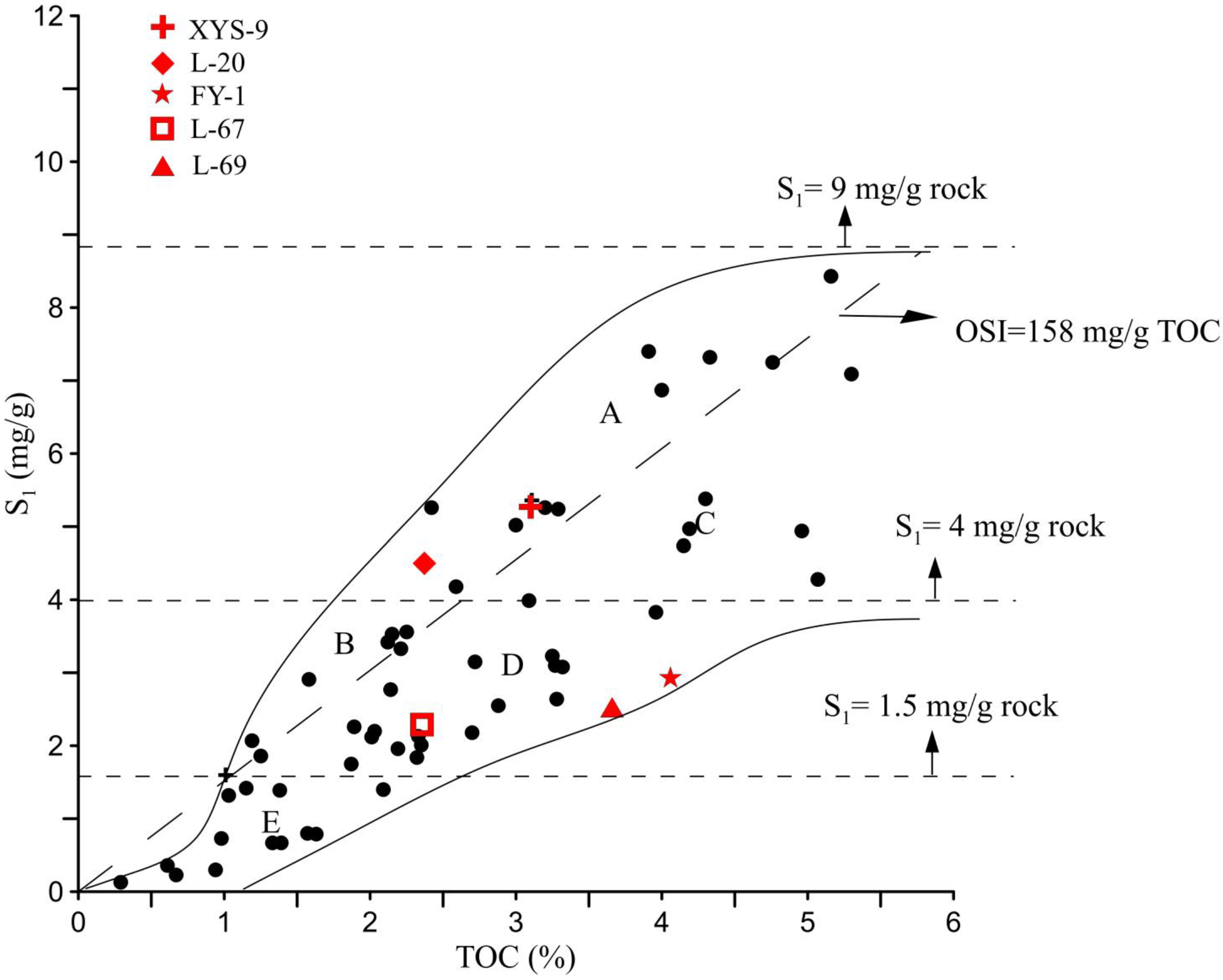
| Depth | Pyrolysis before Extraction | Pyrolysis after Extraction | ||||||||||
|---|---|---|---|---|---|---|---|---|---|---|---|---|
| Tmax | S1 | S2 | HI | OI | TOC | S | Tmax-1 | S1-1 | S2-1 | HI-1 | OI-1 | |
| 3258.1 | 442 | 7.25 | 27.8 | 584.66 | 72.90 | 4.76 | 0.821 | 445 | 0.13 | 22.02 | 1146.8 | 70.31 |
| 3258.4 | 439 | 7.4 | 24.8 | 634.78 | 43.48 | 3.91 | 0.459 | 443 | 0.11 | 17.8 | 787.61 | 88.50 |
| 3258.5 | 440 | 8.43 | 31.0 | 601.36 | 24.61 | 5.16 | 0.649 | 442 | 0.18 | 23.89 | 1264.0 | 95.24 |
| 3258.8 | 440 | 3.33 | 9.71 | 439.37 | 76.92 | 2.21 | 0.239 | 442 | 0.03 | 7.86 | 992.42 | 218.43 |
| 3259.3 | 444 | 5.24 | 18.8 | 572.64 | 44.38 | 3.29 | 0.379 | 447 | 0.04 | 16.22 | 1933.2 | 172.82 |
| 3259.6 | 444 | 3.15 | 12.7 | 466.91 | 65.07 | 2.72 | 0.274 | 444 | 0.04 | 11.74 | 798.64 | 113.61 |
| 3259.7 | 442 | 2.26 | 6.93 | 366.67 | 73.54 | 1.89 | 0.179 | 444 | 0.03 | 5.9 | 656.28 | 194.66 |
| 3261 | 436 | 1.32 | 2.87 | 278.64 | 117.48 | 1.03 | 0.222 | 439 | 0.06 | 1.52 | 49.67 | 51.63 |
| 3262.5 | 439 | 3.42 | 8.88 | 418.87 | 73.58 | 2.12 | 3 | 441 | 0.07 | 6.56 | 321.57 | 85.78 |
| 3265.7 | 443 | 2.77 | 8.24 | 385.05 | 72.43 | 2.14 | 0.39 | 447 | 0.02 | 6.75 | 406.63 | 111.45 |
| 3266.2 | 440 | 5.26 | 15.8 | 656.61 | 61.57 | 2.42 | 0.137 | 441 | 0.01 | 9.7 | 326.60 | 71.72 |
| 3266.6 | 438 | 3.56 | 7.17 | 318.67 | 80.89 | 2.25 | 0.27 | 441 | 0.2 | 5.58 | 221.43 | 85.71 |
| 3268.2 | 428 | 0.36 | 0.76 | 122.98 | 519.42 | 0.61 | 0.225 | 425 | 0.07 | 0.73 | 22.32 | 81.96 |
| 3269.9 | 436 | 0.73 | 1.66 | 168.70 | 250.00 | 0.98 | 1.26 | 438 | 0.05 | 1.42 | 47.97 | 98.31 |
| 3271.3 | 432 | 2.91 | 6.25 | 395.57 | 143.67 | 1.58 | 0.649 | 439 | 0.04 | 2.86 | 262.39 | 286.24 |
| 3272.8 | 440 | 1.86 | 5.55 | 444.00 | 116.00 | 1.25 | 0.575 | 439 | 0.05 | 3.66 | 338.89 | 247.22 |
| 3273.5 | 440 | 5.38 | 27.5 | 640.23 | 37.44 | 4.3 | 0.687 | 442 | 0.08 | 22.49 | 4149.4 | 424.35 |
| 3276.6 | 441 | 4.97 | 25.1 | 598.57 | 27.68 | 4.19 | 0.822 | 443 | 0.07 | 20.22 | 1312.9 | 161.04 |
| 3277.4 | 435 | 7.32 | 24.8 | 572.75 | 34.87 | 4.33 | 0.18 | 438 | 0.12 | 17.84 | 731.15 | 106.56 |
| 3277.9 | 436 | 5.26 | 14.6 | 455.31 | 61.88 | 3.2 | 0.474 | 438 | 0.06 | 12.06 | 648.39 | 126.34 |
| 3278 | 431 | 3.53 | 7.76 | 360.93 | 96.74 | 2.15 | 1 | 435 | 0.03 | 5.85 | 328.65 | 163.48 |
| 3278.5 | 442 | 3.99 | 16.5 | 533.98 | 49.51 | 3.09 | 0.139 | 444 | 0.03 | 15.04 | 624.07 | 100.41 |
| 3278.9 | 430 | 12 | 23.9 | 672.47 | 36.80 | 3.56 | 0.353 | 434 | 0.12 | 13.62 | 1761.9 | 360.93 |
| 3279.3 | 416 | 2.07 | 1.82 | 152.94 | 129.4 | 1.19 | 3.74 | 417 | 0.08 | 0.87 | 57.24 | 192.76 |
| 3280.4 | 435 | 1.42 | 3.24 | 281.74 | 126.0 | 1.15 | 0.301 | 436 | 0.05 | 1.94 | 140.58 | 250.72 |
| 3280.8 | 435 | 1.39 | 3.71 | 268.84 | 128.2 | 1.38 | 0.278 | 440 | 0.06 | 2.76 | 76.45 | 92.80 |
| 3281.4 | 432 | 0.23 | 1.23 | 181.95 | 1010.3 | 0.67 | 0.158 | 436 | 0.02 | 0.76 | 58.02 | 263.36 |
| 3281.6 | 439 | 4.18 | 14.5 | 561.39 | 60.62 | 2.59 | 0.207 | 442 | 0.02 | 5.72 | 136.19 | 78.81 |
| 3283.1 | 432 | 5.02 | 15.8 | 526.00 | 83.67 | 3 | 0.3 | 439 | 0.02 | 9.51 | 270.17 | 100.57 |
| 3283.9 | 433 | 7.09 | 16.5 | 827.64 | 116.58 | 1.99 | 0.11 | 438 | 0.02 | 6.44 | 178.39 | 91.41 |
| 3284.8 | 431 | 9.55 | 18.3 | 495.66 | 44.44 | 3.69 | 0.573 | 434 | 0.1 | 13.12 | 640.00 | 71.71 |
| 3286.6 | 435 | 0.79 | 4.34 | 266.26 | 107.98 | 1.63 | 0.299 | 440 | 0.02 | 2.8 | 80.92 | 44.51 |
| Category | Free Oil (mg/g) | Absorbed Oil (mg/g) | OSI (mg/gTOC) | PRHG-Kerogen (mg/g) | Mobility Evaluation | Resource Evaluation |
|---|---|---|---|---|---|---|
| A | >4 | 2.51~10.32 | >158 | 5.72~23.89 | First-class | Effective resources |
| B | 1.5~4 | 0.95~3.39 | >158 | 0.87~6.56 | Third-class | Potential resources |
| C | >4 | 4.86~10.03 | <158 | 6.44~22.49 | Second-class | Effective resources |
| D | 1.5~4 | 0.96~1.89 | <158 | 3.66~15.04 | Fourth-class | Potential resources |
| E | <1.5 | 0.03~1.54 | <158 | 0.73~2.8 | Fifth-class | Ineffective resources |
| Well | Depth (m) | Sub-Basin | Interval | Average TOC (wt%) | Average S1 (mg/g Rock) | Oil Rate (t/day[b/day]) |
|---|---|---|---|---|---|---|
| XYS-9 | 3388–3405 | Jiyang | Es3 | 3.39 | 5.00 | 38.5 (283.1) |
| L-20 | 2869–2880 | Jiyang | Es3 | 2.45 | 4.58 | 9.2 (67.5) |
| FY-1 | 3199–3210 | Jiyang | Es3 | 4.19 | 3.05 | 2.41 (17.68) |
| L-67 | 3287–3310 | Jiyang | Es3 | 2.37 | 2.29 | 2.1 (15.4) |
| L-69 | 3040–3066 | Jiyang | Es3 | 3.83 | 2.61 | 0.85 (5.87) |
Disclaimer/Publisher’s Note: The statements, opinions and data contained in all publications are solely those of the individual author(s) and contributor(s) and not of MDPI and/or the editor(s). MDPI and/or the editor(s) disclaim responsibility for any injury to people or property resulting from any ideas, methods, instructions or products referred to in the content. |
© 2023 by the authors. Licensee MDPI, Basel, Switzerland. This article is an open access article distributed under the terms and conditions of the Creative Commons Attribution (CC BY) license (https://creativecommons.org/licenses/by/4.0/).
Share and Cite
Yan, Q.; Ping, H.; Yang, X.; Liu, H.; Chen, H. Evaluation of Shale Oil Mobility for the Eocene Shahejie Formation in Liutun Sag, Dongpu Depression, Bohai Bay Basin. Energies 2023, 16, 2101. https://doi.org/10.3390/en16052101
Yan Q, Ping H, Yang X, Liu H, Chen H. Evaluation of Shale Oil Mobility for the Eocene Shahejie Formation in Liutun Sag, Dongpu Depression, Bohai Bay Basin. Energies. 2023; 16(5):2101. https://doi.org/10.3390/en16052101
Chicago/Turabian StyleYan, Qiang, Hongwei Ping, Xin Yang, Honglin Liu, and Honghan Chen. 2023. "Evaluation of Shale Oil Mobility for the Eocene Shahejie Formation in Liutun Sag, Dongpu Depression, Bohai Bay Basin" Energies 16, no. 5: 2101. https://doi.org/10.3390/en16052101
APA StyleYan, Q., Ping, H., Yang, X., Liu, H., & Chen, H. (2023). Evaluation of Shale Oil Mobility for the Eocene Shahejie Formation in Liutun Sag, Dongpu Depression, Bohai Bay Basin. Energies, 16(5), 2101. https://doi.org/10.3390/en16052101







